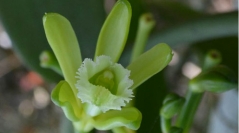

 European Journal of Taxonomy
2017 (284) - Pages 1-26 (EJT-284)
European Journal of Taxonomy
2017 (284) - Pages 1-26 (EJT-284)We describe a new vanilla species growing in sympatry with Vanilla planifolia Jacks. ex Andrews (Orchidaceae) in the province of Limón, Caribbean coast of Costa Rica. The morphology of the reproductive and vegetative organs observed on vines cultivated under shade-house, the nuclear (Internal Transcribed Spacer) and plastid (matK) nucleotide sequences, as well as the contents of aromatic compounds measured in ripe fruits, show that this species is close to but distinct from V. planifolia. The name V. sotoarenasii M.Pignal, Azofeifa-Bolaños & Grisoni sp. nov. is proposed for this new Vanilla species endemic in Costa Rica. It is especially distinguished from V. planifolia by a reduction of about 30% of the size of the fruits and flowers, by a divergence of ITS sequences for at least two species-conserved nucleotides compared to seven other species of the V. planifolia group, and by the presence of anisic compounds and low content of phenolic compounds (including vanillin) in the fruits. These results confirmed the extension of the area of distribution of V. planifolia southward to Costa Rica, where a recent speciation process occurred. Because of its particular agronomic and aromatic properties, V. sotoarenasii sp. nov. could represent a valuable biological resource for the vanilla industry.
Barcoding, Costa Rica, Limón, radiation, Vanilla planifolia, V. sotoarenasii.